
This page was last edited 09/15/2005
 |
This page was last edited 09/15/2005 |
A skeptic's analysis will be included when he completes it, with his permission.
music: Exorcist
Click on left image for animated gif (669K), right image for reference.
FT lights flared briefly during initial approach (seen best on animated gif), which was a trademark of many AOP performances. As AOP flew over Cornet, the target was briefly lost and had to be reacquired, which required that Cornet zoom out to find the AOP and then zoom back in on it.
Individual video frames of fly-over: The approach.
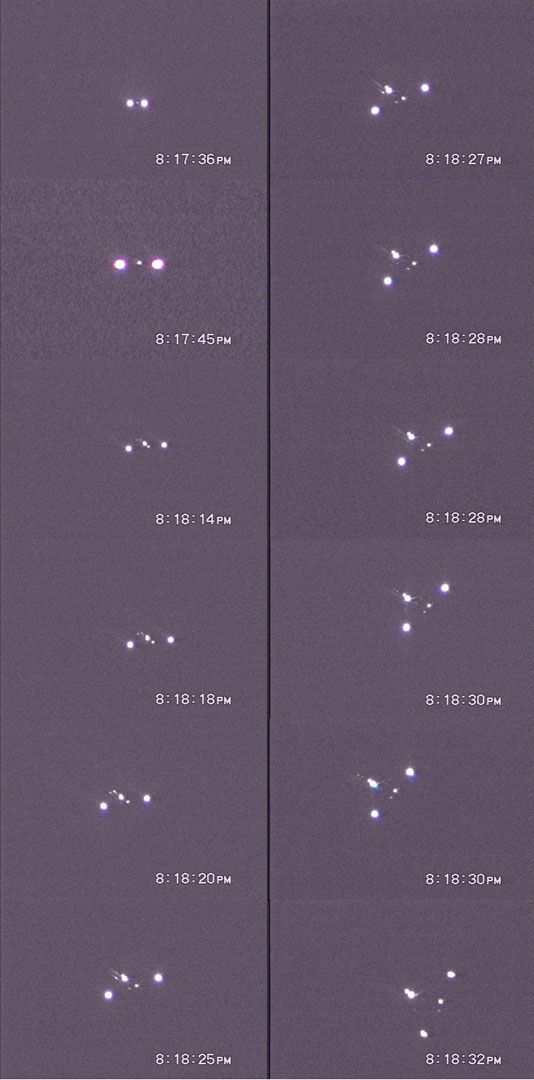
Individual video frames of fly-over: The departure.
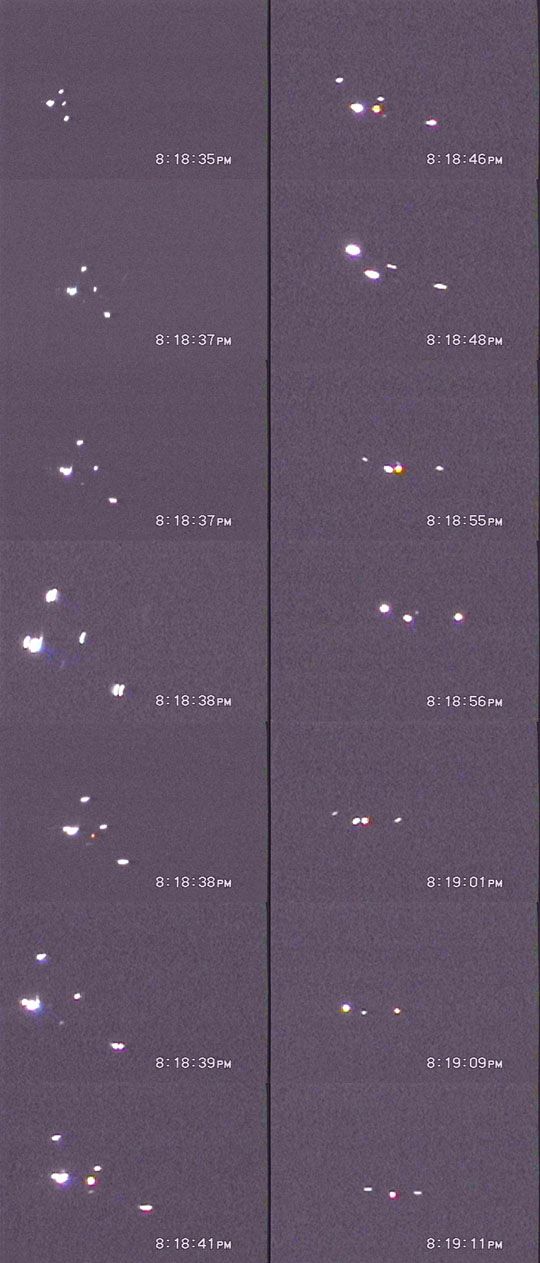
In the RealPlayer movie Cornet says, "Here's something else higher up - another plane - will pass it." The AOP passed in front of radio tower lights, which Cornet mistook for airplane lights.
![]()
The lights the AOP passed (see image above) are on radio towers located on a mountain top across the Hudson River from Newburgh (east of Beacon, NY), 19.6 miles from the camera. The top of the mountain on which the towers or beacons are located is 400 feet above the river. The radio towers are at least 300 feet tall, making the highest light about 800 feet above the river or valley floor. When the AOP passed in front of the towers it was less than 7 miles from the camera and its relative position was only slightly higher than the top light. Accounting for perspective, the maximum altitude of the AOP had to be no more than 800 feet.
FAA regulation 91.177 Minimum altitude for IFR operations. (a) Operation of aircraft at minimum altitudes. Except when necessary for takeoff and landing, no person may operate an aircraft under IFR below - (1) The applicable minimum altitudes prescribed in Parts 95 and 97 of this chapter; or (2) If no applicable minimum altitude is prescribed in those parts -- (i) In the case of operations over an area designated a mountainous area in part 95, an altitude of 2,000 feet above the highest obstacle within a horizontal distance of 4 nautical miles from the course to be flown; or (ii) In any other case, an altitude of 1,000 feet above the highest obstacle within a horizontal distance of 4 nautical miles from the course to be flown (
AIM/FAR 1994 airman's information manual / federal aviation regulations).Composite graph to show manner of banking and turn.
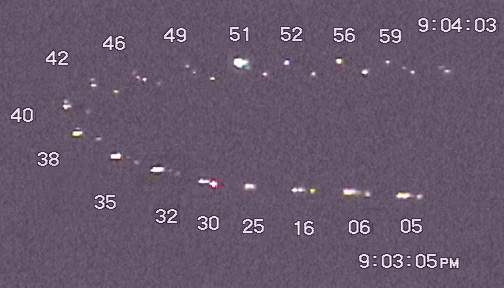
The final descent and disappearance: Headlights pointing towards camera; craft moving towards observer, and drifting sideways below tree tops in an area where there is no known landing strip or field long enough and flat enough to land an airplane safely.
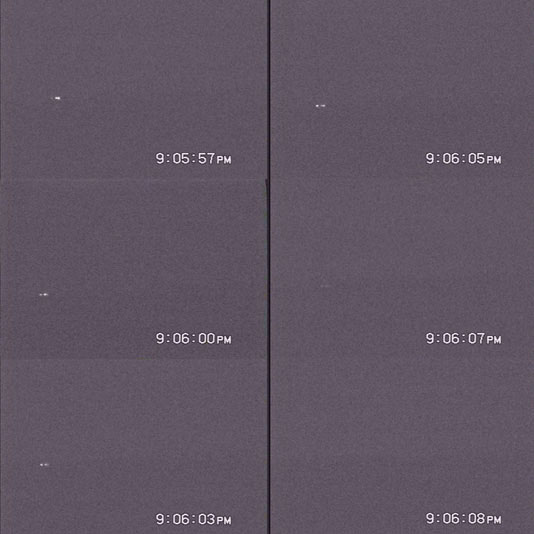
In order to understand the similarities and differences between the lights on AOP No. 1 and those of conventional jetliners, several animated gifs and comparisons are made below with a McDonald Douglas DC-8 and a Boeing 767.
Note how some lights reflect of engine pods as the airplane gradually turns towards Kennedy airport.
|
Even though the aircraft is not visible in most of the frames, you can make out its narrow wings at its closest approach to the camera.
|
Comparison of lights on a Boeing 767 with FT lights (on approach)
Wings versus Triangle
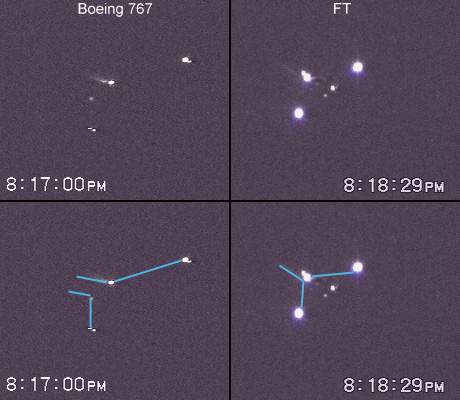
Comparison of lights on a Boeing 767 with FT lights (during departure).
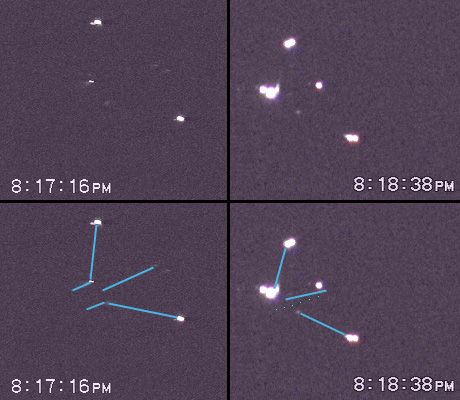
Lights on FT create the illusion of symmetry (blue lines), but details reveal the deception (blue dots).
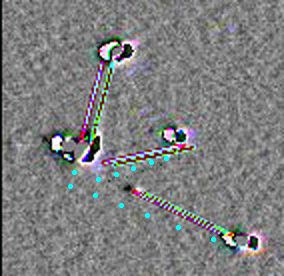
There is no room for a fuselage. The "beams" of light extending out in front of the FT are not reflections off of a fuselage. They are reflections off of booms or pipes that are sticking out the front at the midline. Reflections off of engine pods are usually momentary events and dependent on angle of incidence and position of observer (e.g. flash off of left engine pod of DC-8 in animaged gif above). Reflections caused by large or bright lights tend to illuminate an entire engine pod, making it visible and easily identifiable (See animated gif of DC-8). The small white dots along the leading edge of the FT are probably reflections, but not off large engine pods. The three bright lights on the FT would have bathed any engine pods (if present) in light, making them completely visible, as is the case for the DC-8.
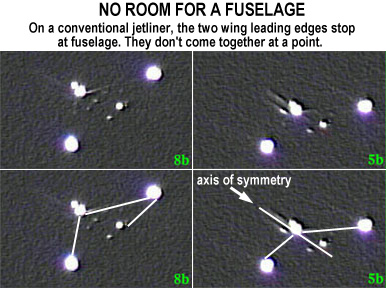
Anomalous Rotation of Central Nose Lights Backwards
How does one explain a set of "landing" lights that can be seen as brightly from the rear of an aircraft as from the front? Normally, the fuselage of a jetliner blocks visibility of landing lights from the rear (see animations above). How does one explain the rotation of lights so that they point forwards and backwards? This is not something fixed lamps on a conventional aircraft can do.


Lower rendition in magenta courtesy, Steve Meyers.
The reflections off of the booms that stuck out in front of the FT were interpreted by Meyers as reflections off of a fuselage. The pair of small lights that appear briefly along the boom were interpreted as window lights on a jetliner, and the small faint lights along the starboard leading edge were interpreted as reflections off of engine pods (they are visible in seven frames involving seven seconds and different angles; see composite graphic above; compare with reflections on DC-8 engine pods in animated gifs above). The vertical line artifact is lens flare typical of the Sony camcorder lens system when a light becomes too bright.
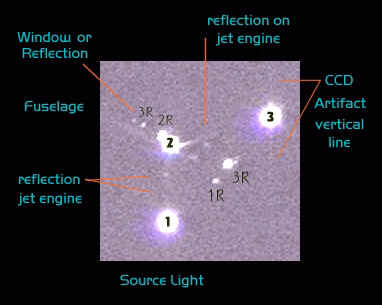
Image courtesy of Steve Meyers.
Now compare those two small lights along one of the booms sticking out front to the way they appeared on this type of FT when videotaped flying over Pine Bush, NY, on 4 June 1997. I think that even the most stubborn skeptic will have to admit that aircraft navigation lights do not rotate like this.
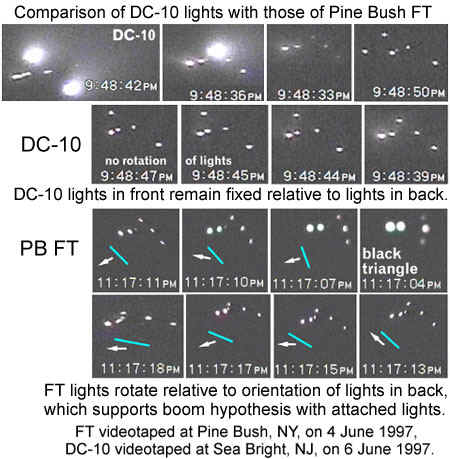
Regardless of how much someone wants to identify the Pine Bush FT as a conventional jetliner, the fact that the leading edges of the triangle come together to form a point rules out all conventional airframes with a central fuselage. What Macedo and I saw fly over us was triangular in shape with no fuselage, but with thin narrow objects (booms, pipes) sticking out front and back.
Listen to what Ellen Crystall and Cornet say regarding the same type of FT, which flew over them on 28 April 1993 (the subject of The Performance).
Ellen Crystall said, "I saw something last night that wasn't a plane. It was a triangle, and it had some extra stuff on the front and the back." Rick asked, "Did it make noise like that?" Ellen said, "Bruce, did that thing I, we saw last night make noise?" Bruce responded, "Yes, like that."
Anomalous Strobe Sequence as FT AOP Departs
The strobe pattern was semi-random and the outboard strobes were out of sync. The outboard lights consisted of a pair of small white lights, one of which strobed. Occasionally both these lights on one side went out, as well as the central white light at the rear of the FT. On one occasion that central rear light strobed red. The pattern, including the lights which briefly went out, implies that the strobes were controlled either by a random generator or by manual controls operated at the discretion of the pilot and/or crew.
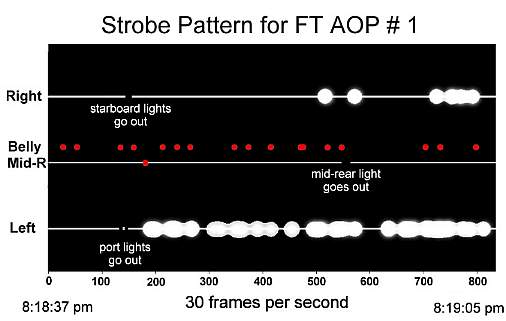
Frequency Spectrograms (Sound Analysis)
Checkerboard pattern and distinct frequency bands (five) are present, which is unlike that of conventional jet engine sound. In addition, the amount of white noise is well below that of conventional jet engines.
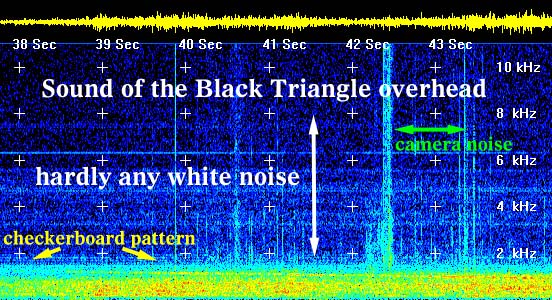
A conventional jet produces a lot of white noise due to the spinning of jet engine turbines. If that sound were recorded and broadcast from speakers, much of that white noise would not be reproduced, and what was reproduced would not be at the same volume of the original sound. That is because of the limitations imposed by any speaker system.
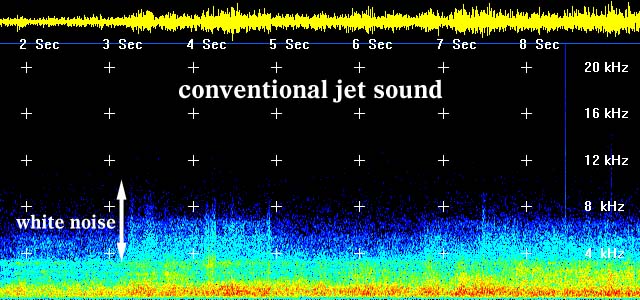
In order to document examples of fake sounds produced by black Flying Triangles, an eye witness account is reproduced here. Why a fake sound? Camouflage! Who's going to react to something that is familiar, unless it comes directly at them?
----- Original Message -----
To: bcornet@monmouth.com
Sent: Monday, March 13, 2000 11:14 PM
Subject: Re: AOP's
I live at the northern end of San Francisco Bay, 30 miles from The City. The area
is built up, but with patchwork marshy areas, shopping center, freeway, and open
space. One evening at dusk, I was here at my webtv apparatus when I heard a distant
motor throbbing of a very large helicopter. Being somewhat familiar with these large
military craft, I did not react. Until it kept getting louder and closer and
louder.... Finally it was so disturbing in its racket (the house was shaking), becoming
alarmed I ran from my room and out onto a back deck behind the house. The sound was
coming from across the lagoon over the top of houses 300 ft away. But in the closing
darkness of the evening, I could not see a helicopter, nor any aviation lights
whatsoever. Nearly in a panic because the sound was heading my direction at what
surely was tree top height, I strained to see and could not see anything. It then
flew directly over my house at a very slow pace. Looking directing up into the night
sky was a barely perceptible black triangle.. gigantic in size with no lights on. I
was in shock. I could barely make out the triangle, but never did see the shape of a
helicopter. After reading some of your material, my thought is I am the victim of a
ruse. There never was a helicopter, but rather the low flying triangle may have been
mimicking the copter sound. I asked several neighbors about it, and they heard the
helicopter, but never bothered to go outside and look to see. It was not easy to
discern anything at all, but for the fact that I happened to look directly up as it passed
over. No lights, just lots of copter noise as it glided past.
I have had similar experiences as you describe, back in l972 while using
binoculars and observing the aircraft flying in and out of San Franciso Airport.
What I thought I saw, I have never accepted, until
studying your website. Thanks!
james askew
Novato, California
Analysis of Landing
FT as it slowly dropped below tree top level with trees standing behind lights as it flew slowly towards the observers.

FT disappeared into an area (presumably over a lake or field) between tree rows, not behind a horizon defined by the trees in the background.
Send mail to bcornet@monmouth.com
with questions or comments about this web site.
Copyright © 2000 Sirius Onion Works.
This page was last edited 09/15/2005